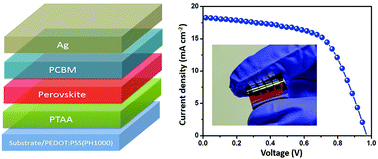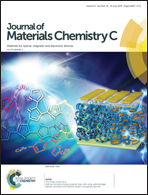High-performance metal oxide-free inverted perovskite solar cells using poly(bis(4-phenyl)(2,4,6-trimethylphenyl)amine) as the hole transport layer†
Abstract
In this work, we used poly(3,4-ethylenedioxylenethiophene):poly(styrene sulfonate) (PEDOT:PSS, PH 1000) and poly(bis(4-phenyl)(2,4,6-trimethylphenyl)amine) (PTAA) as anode and hole transport materials, respectively, for fabricating metal oxide-free inverted perovskite solar cells (PSCs). The sheet resistance of the PEDOT:PSS (PH 1000) anode was reduced to 76 Ω sq−1 after treatment with ethylene glycol and phosphoric acid, a level comparable to that of conventional indium tin oxide. The hydrophobicity of PTAA improved the perovskite crystallization, facilitating performance improvements in the PSCs. A high power conversion efficiency (PCE) of 14.23% was achieved for these structured rigid PSCs on a rigid glass substrate, with the short-circuit current density, open-circuit voltage, and fill factor of 19.88 mA cm−2, 1.02 V, and 70.2%, respectively. Flexible PSCs on a polyethylene terephthalate substrate exhibited a high PCE of 10.51% with excellent bendability. Our results indicate that using anodes of PEDOT:PSS (PH 1000) and hole transport layers of PTAA presents a promising fabrication method for high-performance rigid and flexible metal oxide-free PSCs, which suggests future large-scale and roll-to-roll production.



 Please wait while we load your content...
Please wait while we load your content...